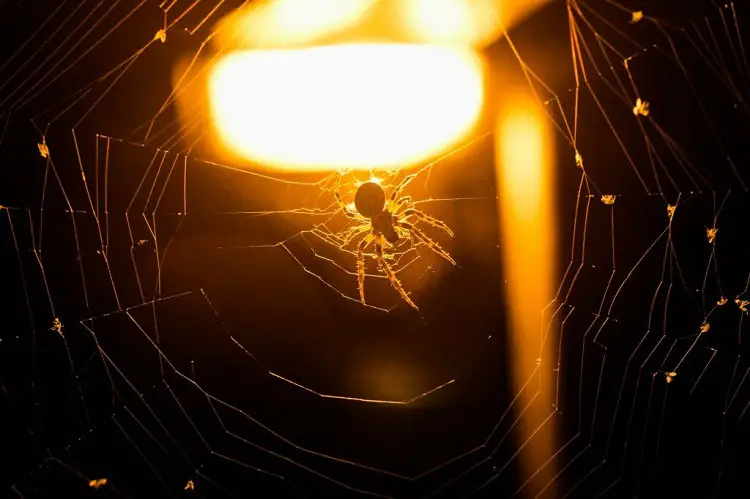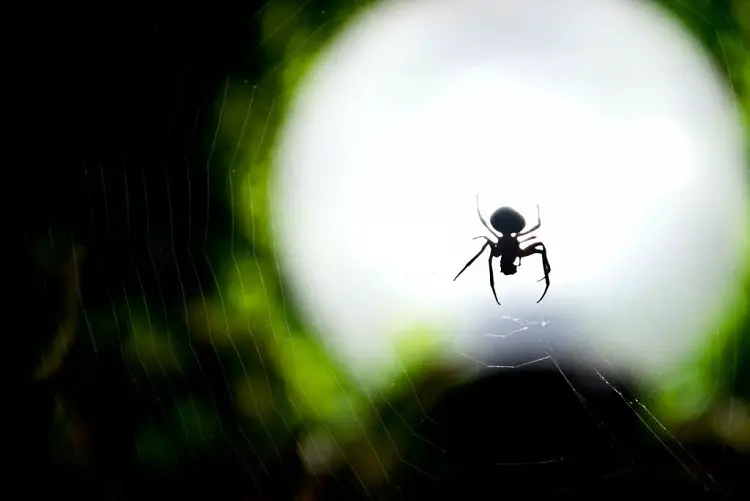The invention of LED (Light Emitting Diode) lights has brought about a revolution in lighting technology, characterized by energy efficiency, durability, and an eco-friendly footprint.
However, a fascinating question has emerged: Do LED lights attract spiders?
The answer to this question is not straightforward, as it depends on various factors.
LED lights are bright and can provide ample space for insects to crawl and hide. However, the color and intensity of the light play an important role.
While LED strip lights and LED lighted mirrors may run cooler than other lighting options, they emit bright light that attracts spiders and bugs easily.
However, some studies suggest that LED lights have a lower attraction for insects and spiders than traditional lights because they emit less heat and UV radiation.
However, other studies have shown that spiders are attracted to the light wavelengths that LEDs emit, particularly blue and green light.
This article aims to answer questions like Do LED lights attract spiders, scientific aspects of spider behavior, their response to LED lights, and factors such as light spectrum, intensity, and potential implications for spider activity.
Spiders and LED Light Behaviour
Spiders, being primarily night-time creatures, possess photoreceptors that are highly sensitive to light, especially in the ultraviolet (UV) and visible light spectrum.
These receptors play an essential role in various biological functions such as circadian rhythm regulation, navigation, and hunting.
Research indicates that spiders are particularly drawn to UV light, a component common in traditional incandescent and fluorescent lights.
Conversely, LED lights emit significantly less UV light, making them less attractive to spiders in comparison.
Overall, the relationship between spiders and LED lights is an intriguing topic that continues to be studied and explored by scientists.
Do Led Lights Attract Spiders?
Many people wonder if LED lights attract spiders. The answer to this question is not straightforward, as it depends on various factors.
Some studies suggest that LED lights have a lower attraction for insects and spiders than traditional lights because they emit less heat and UV radiation.
However, other studies have shown that spiders are attracted to the light wavelengths that LEDs emit, particularly blue and green light.
Furthermore, factors such as the brightness and placement of the LED lights can also influence spider behavior.
Spiders follow their food source (which is usually insects), so it’s only logical that they would want to build a home where they can find an abundance of prey leading to their attraction to LED light.
In summary, it is difficult to determine conclusively whether LED lights attract spiders or not, as it is a complex issue that requires further investigation.
Why Do You Find More Spiders Near LED Strip Lights?
LED lights, including LED strip lights, can be quite bright and intense depending on their design and settings.
Spiders are often attracted to bright light sources, as they can lure their prey, such as flies and moths, which are themselves attracted to light.
If there are more insects around LED strip lights, spiders may be more likely to congregate in those areas.
LED strip lights are often installed near doorways, windows, or outdoor areas where insects are likely to congregate.
Spiders tend to follow their prey, so if insects are attracted to the LED lights and subsequently become caught in spider webs, it may create the perception that spiders are attracted to the lights themselves.
The illumination from LED strip lights can make spider webs, more noticeable. Spiders may strategically place their webs in well-lit areas where they are more likely to catch prey attracted to light.
LED lights emit very little heat compared to traditional incandescent lights. Spiders are often attracted to warmth, so the absence of significant heat from LED lights may deter spiders that seek warmer areas.
How Can I Prevent LED Lights From Attracting Spiders

To minimize the attraction of spiders to LED lights or any lighting in your vicinity, you can implement various strategies to deter both spiders and their prey (insects).
Here are some effective approaches to help keep spiders away from LED lights:
1. Use LED Lights with Minimal UV Emission
If you are looking to avoid having spiders in your house, one effective strategy is to choose LED lights that emit minimal UV light.
Spiders are attracted to UV light, as it is similar to the sun’s light which they use for navigation.
Thus, opting for LED bulbs that have lower UV emissions can help to reduce their attraction to the light source and prevent them from coming inside your home.
This can also be a more energy-efficient option as LED lights generally consume less energy than traditional incandescent bulbs.
2. Select LED Lights with Lower Intensity
If you’re dealing with a spider infestation, it’s important to know that spiders are often attracted to bright lights.
So, if you want to make your home less appealing to these eight-legged creatures, you may want to consider adjusting the brightness or intensity of your LED lights.
By lowering the intensity, you’ll create a less appealing environment for spiders, potentially reducing their presence in your home.
It’s a simple step you can take to make your living space more comfortable and less spider-friendly.
3. Install Motion-Activated Lighting
A great way to reduce energy consumption and potentially deter insects and spiders is by using motion-activated LED lights instead of keeping them on constantly.
With this method, the lights will only illuminate when someone or something is nearby, making them more efficient and cost-effective.
Additionally, this can help to reduce the number of insects and spiders that are attracted to the lights, as they will not be on for extended periods.
By implementing this simple change, you can enjoy a well-lit space while also reducing your energy bill and minimizing the presence of unwanted bugs.
4. Strategically Place Lighting
To keep insects at bay and reduce the presence of spiders in your home, it is essential to position LED lights strategically.
It is recommended to place the lights away from entry points and windows as well as areas where insects are known to congregate, such as piles of leaves or standing water.
By doing this, you can minimize the attraction of insects to your home and make it less hospitable for spiders to spin their webs.
5. Regularly Clean and Maintain Lights
To ensure optimal performance and longevity of your LED lights, it is crucial to keep them clean and free of dust, webs, and debris.
It is worth noting that spiders are often attracted to existing webs or debris on the lights, which could potentially harm the lights or cause a fire hazard.
Therefore, it is highly recommended to perform regular cleaning to deter spiders and prevent any potential damage to your LED lights.
6. Seal Entry Points and Cracks
To effectively keep spiders away from both LED lights and your living spaces, it is important to carefully examine your home or building for any gaps, cracks, or openings that may serve as entry points for these pests.
Seal any openings you find using appropriate materials, paying special attention to areas around windows, doors, and utility lines.
This will create a barrier that prevents spiders from entering and helps ensure your home remains spider-free.
7. Regularly Remove Webs
To maintain a spider-free environment, it’s recommended to routinely check and remove any spider webs that may form near the LED lights in your vicinity.
By doing so, you discourage spiders from considering the area a suitable location for web-building and hunting, as they tend to prefer undisturbed areas for their webs.
Additionally, removing the webs can help to improve the effectiveness and longevity of the LED lights as spider webs can accumulate dust and debris, obstructing the light output.
Therefore, regularly inspect and clean the area surrounding the LED lights to ensure they remain free from spider webs.
8. Use Natural Repellents
If you’re looking for a natural way to keep spiders at bay, there are a few options you might consider.
One is to use peppermint oil, which spiders are known to dislike. You can dilute the oil with water and put it into a spray bottle, then spray the mixture around areas where spiders might be hiding, such as in corners or under furniture.
Another option is vinegar, which can also repel spiders. You can mix equal parts vinegar and water and use it in the same way as the peppermint oil spray.
Finally, citrus-based solutions can also be effective. You can use lemon juice, orange oil, or any other citrus-based product and apply it in the same manner as the other sprays.
By spraying these solutions around your LED lights or other areas where spiders might congregate, you can create a natural barrier that will discourage them from taking up residence in your home.
9. Utilize Bug Zappers or Traps
If you’re looking to reduce the spider population around your home, consider using bug zappers or insect traps.
It’s important to place them away from LED lights, as the lights can attract insects and ultimately provide spiders with a potential food source.
By capturing and eliminating insects before they come near your home, you can help reduce the spider population and keep your surroundings bug-free.
10. Install Insect Screens
Insects are drawn to LED lights, and spiders are drawn to insects.
To prevent spiders from setting up camp near your LED lights, it’s important to use insect screens on doors, windows, and vents. Insect screens will prevent insects from getting close to your lights, reducing the attraction of spiders.
By taking this simple step, you can help keep your home spider-free and reduce the need for chemical insecticides.
11. Trim Vegetation and Landscaping
To minimize the presence of spiders and their prey around LED lights, it is advisable to regularly trim the trees, shrubs, and vegetation near those lights.
This is because such plants and foliage provide hiding spots and nesting places for spiders as well as their prey, which can attract them to the area.
By keeping the surrounding area clear of overgrown vegetation, you can reduce the likelihood of spider infestations and help maintain a pest-free environment.
12. Consult a Pest Control Professional
If the spider infestation is severe or persistent, consider seeking assistance from a pest control professional to assess the situation and implement appropriate measures.
By incorporating these practices, you can create an environment less attractive to spiders and their prey, thereby minimizing their presence around LED lights.
Read Also: How To Get Rid of Warps in Your Home
Final Words
Ultimately, LED lights do not necessarily attract more spiders than other types of lighting.
But they have surely become attractive options for many homeowners due to their energy efficiency and long lifespan, spiders now have to adapt to using them as a source of light.
To avoid LED lights attracting spiders, ensure that your LED lights are pointed away from the ground and that you go for LED dimmers or lower-wattage bulbs to reduce the amount of light emitted.
If you have an infestation of insects near your strip lights, clean the area and use repelling sprays that contain scents like citrus or cedar.

